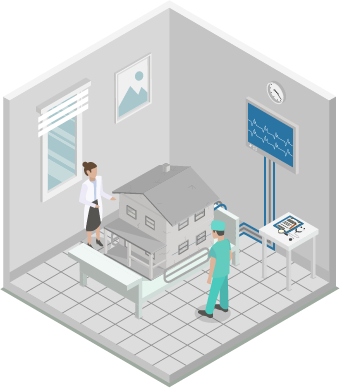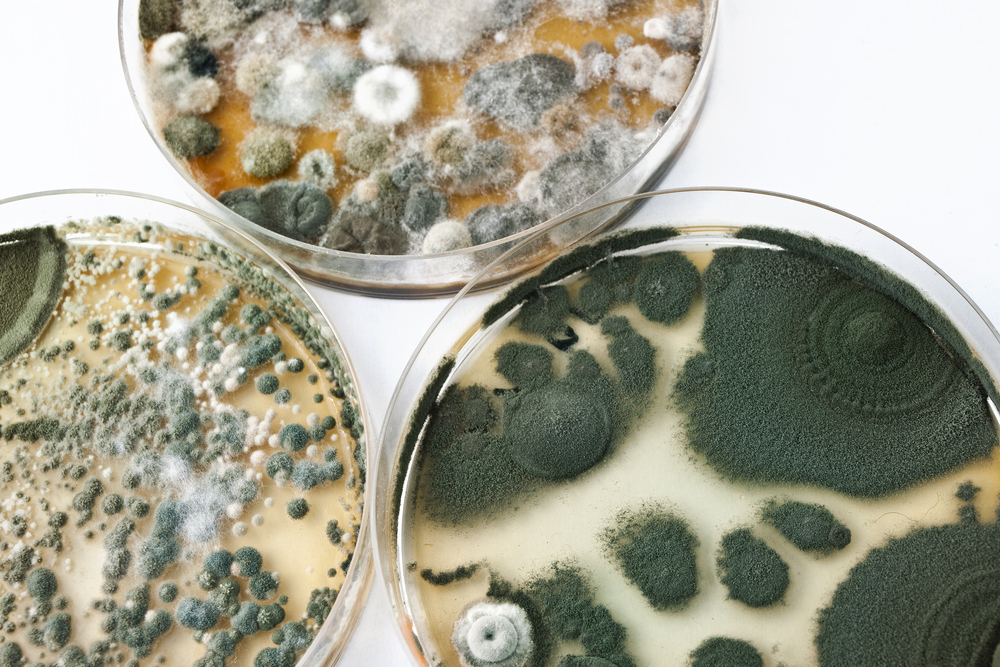How does one stop mold growth in their homes?
Mold spores are everywhere, both indoors and outdoors. Not only is it impossible to totally eradicate them, you don’t need to. The problem with mold isn’t just the spores, it’s mostly the mold growth created when the spores germinate and grow. If you’re reading this, it’s likely you want to learn how to stop mold growth in your home.
In the picture above, spores have grown into large colonies. Compare the colonies to the tiny specks scattered between the colonies. The specks are individual spores and baby colonies before they have grown up. The goal is to prevent the spores from germinating with explosive growth into colonies, and the colonies from expanding and covering large areas of the surface of walls, wall studs, clothing in closets, flooring, furniture, and ceilings.
Get to know mold a little bit.
Spores needs two things to grow into mold colonies: food and water. Food for mold growth is found on many of the surfaces in your home, including drywall, window frames, sheet rock, carpeting, and furniture. The food is the dust. Common, ordinary, house dust. Mold food, like the spores themselves, is everywhere and can’t be eradicated.
What isn’t everywhere, and what can be managed, is sufficient water. Mold spores are the seeds of the mold growth (microscopic plants). And, as with the seeds of ordinary plants like tomatoes or oak trees, they need the right amount of water, long enough, to sprout and grow. Stop the moisture and you stop the seeds (the spores) from sprouting. If they have already started growing, reducing the moisture makes them stop growing just like the grass in your yard when it turns brown from lack of water.
Flooding and significant leaks are almost always obvious. We know to quickly take action by stopping the leaks and removing the water. It is the less obvious sources of moisture that can cause the worst problems of mold growth with the increased risk of structural damage to houses and health damage to people.
By avoiding four simple mistakes, you can stop most mold from growing in your home. Get to know the truths and myths about mold here.
Here are four actions to stop unknowingly growing mold in your home:
1. Not fixing small leaks
You may think that the leaky ice maker in your fridge or the dampness creeping out from under the dishwasher is just a nuisance. But the repeated wetting-drying cycle of the floor will eventually cause mold growth. Left unattended, the dampness oozes below the flooring, soaks up the sides of the cabinets, and gets trapped inside walls. Unattended moisture accumulation grows mold and eventually deteriorates the drywall, framing, subfloor, and supporting structures. What started as a simple, slow leak in the kitchen, for example, can turn into one of the most complex and expensive remediation and repair challenges. The slow leaks in bathrooms under sinks, around tubs or showers, and especially from under the toilet fixture can easily turn a $50 fix into a major repair costing several thousand dollars.
2. Not running bathroom fans
Most people know bathroom fans remove odors. But their more important function is for removing moisture. Bathing, and especially showering, puts tremendous amounts of moisture into the air. Notice this the next time the bathroom mirror fogs up – that “fog” is condensed moisture from the air, created by the shower water. Some of the hot water from the shower head turns into steam (moisture in the air) and then condenses back into liquid water on the cooler mirror. In fact, if you look closely you will find water may have condensed onto the ceiling, walls, and maybe even the towel racks and the towels themselves.
Everywhere in the room that has a similar temperature to the mirror. The mirror is the most visually obvious but is not the only surface affected. The brown spots on some ceilings (that keep coming back) is a form of mold that keeps growing because of the periodic moisture from the shower.
However, an additional issue can be caused by the moisture in the bathroom air spilling out into the bedroom and partially into the rest of the house, adding to all other sources of moisture – like from cooking.
3. Not running range hood fans
Boiling and steaming food, even normal cooking, puts large amounts of moisture into the air of the kitchen. Because kitchens are much larger than bathrooms it is less likely that water will visibly condense on surfaces. But the moisture is still there, adding to the shower moisture and any other sources, whether from inside the house or from the outside air. This total “load” of humidity increases the risk of condensation.
4. Not venting your clothes dryer to the outside
Clothes dryers are another large source of moisture inside houses. The larger the family the more the dryer is used, the more moisture is that can be released. The smaller the house the higher the accumulation of moisture in the smaller space. Think of it this way. When you load the wet clothes into the dryer and turn it on, the clothes come out dry. Where did all that water go? It didn’t disappear. The heat evaporated it from the wet clothing and it went somewhere. If the dryer isn’t vented to the outside air, all that moisture will go into the air of the laundry room. Then, much like the hot shower water evaporated into the bathroom, or the cooking water evaporated into the kitchen, the total moisture of the inside air increases.
One last word on venting clothes dryers: They must exhaust the moisture through an exterior wall to the outdoors – not into an attic or crawlspace where even greater damage can occur over time.
Showers, cooking, and laundered clothes have excess moisture. You can’t stop the unavoidable. But you can determine where all that moisture goes. Blowing all that moisture anywhere other than directly outdoors merely changes the location of where the mold will grow and where the potential structural damage can occur. Out of sight may be out of mind, but it isn’t out of doors. For more information on mold, read our Ask an Expert series on remediating mold here.
To learn more about additional conditions in your home that may be impacting your health, take the Hayward Score survey today! Get suggestions on how to make your home healthier, as well as detailed, personalized Action Plans to get you started.
Getting to a healthy home can seem daunting, but it is possible and our experts are here to help! You can Ask an Expert, and one of our Hayward Score team members will contact you within 2 working days to schedule your call.
Hayward Score helps you discover how your home may be impacting your health in minutes – – for FREE!
Answer a quick set of questions then get a personalized list of action items. Transform your home and health today!

ARE YOU CONCERNED YOUR HOME IS MAKING YOU SICK?
Our guide on indoor quality will help you diagnose possible issues and implement intelligent solutions to improve the quality of the air inside your home.















